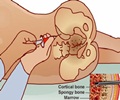An unusual microscope that has a tip the size of a needle may help scientists look at muscle fibres in live humans without causing much of discomfort to the patient, Stanford researchers have revealed.
The researchers say that the microendoscopy technique for viewing sarcomeres, muscle fibre about three millionths of a meter long, has advantages over methods like muscle biopsy wherein a portion of the muscle is removed for examination.A research article on this study describes sarcomeres as the basic contracting engines of muscle that generally pull in a coordinated fashion, allowing people to walk down the sidewalk or throw a sinking curveball from the pitcher's mound.
However, muscular dystrophy and other diseases of diminished muscular control are believed to change the length of sarcomeres, and cause havoc with muscle control because the force exerted by muscle is critically dependent on length.
With a view to seeing sarcomeres in action, experts from Stanford's Bio-X program came up with a needle-thin probe, which is inserted through the skin into muscle.
The researchers say that when a flash of finely tuned laser light is sent through the probe, the sarcomeres respond with light of their own to form a snapshot of muscle in action.
According to them, the images can be seen in real time on a display screen, and that it is also possible to obtain a three-dimensional movie by changing the depth of focus of the rapidly scanning device.
Advertisement
For the first time, "it allows us to view individual sarcomeres in live humans," he added.
Advertisement
He says that the new technology may also have implications for biomechanics, orthopedic reconstructions, prosthetic devices, and tendon transfers, in which tension adjustments are a crucial element for patients relearning how to walk or grasp.
"If you measure the length of the sarcomeres during surgery, then you can adjust them to work at their optimal length, giving maximum muscle strength," Delp said.
Source-ANI
RAS/N









